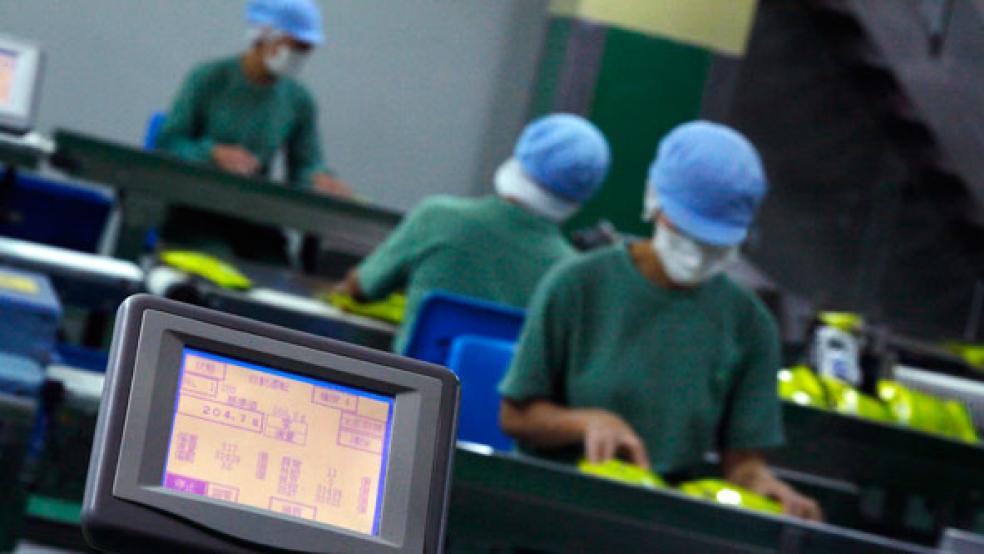By Steven C. Johnson and Andy Bruce
Chinese manufacturing output grew last month for the first time in more than a year but a surprise contraction in U.S. factory activity tempered optimism about the health of the world economy on Monday.
Business surveys also showed the euro zone’s manufacturing sector shrank for a 16th straight month, though a little bit less rapidly than in October.
A rise in HSBC’s China manufacturing PMI to 50.5 in November, its first time above the 50-point growth threshold in 13 months, suggested the world’s second biggest economy may be heading into 2013 with more momentum after struggling this year.
The expansion in Chinese factory activity should provide a boost for world growth, particularly since recovery in the debt-strapped euro zone still appears a long way off.
But an unexpected contraction in U.S. manufacturing this month, the sector’s worst showing in more than three years, rattled market confidence and added to worries about the health of the world’s largest economy, particularly as it faces a possible budget crisis over tax and spending policy at year end.
The Institute for Supply Management said its national index of factory activity fell to 49.5 from 51.7.
"There are two ways of looking at this — we had two months of growth and now we are back to contraction. That is one way," said Christopher Low, chief economist at FTN Financial. "The other, which is a little more realistic, is that since May the index has been very close to 50 and I think what we are seeing is that manufacturing has stalled and has yet to recover."
A separate report from information firm Markit painted a different picture of U.S. manufacturing, with the sector growing at its quickest pace in six months, though firms said that was in part due to an increase in demand following Hurricane Sandy, which hit the east coast in late October.
CHINA TAKES THE LEAD?
The big emerging economies that have contributed most to global growth in recent years have been sputtering of late, with India expected to post its weakest full-year GDP expansion in a decade.
Brazil logged an unexpectedly weak third quarter, though manufacturing expanded last month at the quickest clip in nearly two years, suggesting a gradual turnaround.
That has left investors once again hoping China will take up the slack, after seven straight quarters of slowing growth.
"There is growing confidence that China’s economy bottomed in July-September, with signs of firmer external demand," said Hirokazu Yuihama, a senior strategist at Daiwa Securities.
But some analysts said the global significance of China’s data was unclear. "They’re not a pointer necessarily that the rest of the global economy is recovering," said Philip Shaw, chief economist at Investec in London. "We suspect there is an element of domestically-driven growth coming through in the numbers there."
Added Joshua Shapiro, chief U.S. economist at MFR, a global consulting firm: "The overall picture is certainly one of a weak global economy. Europe is weakening clearly, Japan is going nowhere, and I don’t know what to make of the wiggles in Chinese economic data, to be perfectly honest."
Aside from China, the outlook for other major Asian economies looks uncertain, especially because easy monetary policy in the developed world has pushed up the value of currencies in the likes of Korea and Taiwan, hurting exports.
Manufacturing continued to contrast in both countries last month, while India’s factory sector expansion remained well below the rate seen in the years before the global financial crisis.
EUROPE’S STRUGGLES PERSIST
Markit’s Eurozone manufacturing PMI rose to 46.2 in November from October’s 45.4, though it stayed below the 50 mark dividing growth from contraction for the 16th straight month.
While the decline among the euro zone’s embattled factories eased in November, the latest PMIs showed the economy is on course for its worst quarter since the depths of early 2009.
"With official data lagging the PMI, the rate of GDP decline is likely to have gathered pace markedly on the surprisingly modest 0.1 percent decline seen in the third quarter," said Chris Williamson, chief economist from survey compiler Markit.
British manufacturing activity shrank less than expected in November, but the sector remained fragile as orders edged down, a survey found on Monday.
(Additional reporting by Lucy Hornby; editing by Jeremy Gaunt and Clive McKeef)




